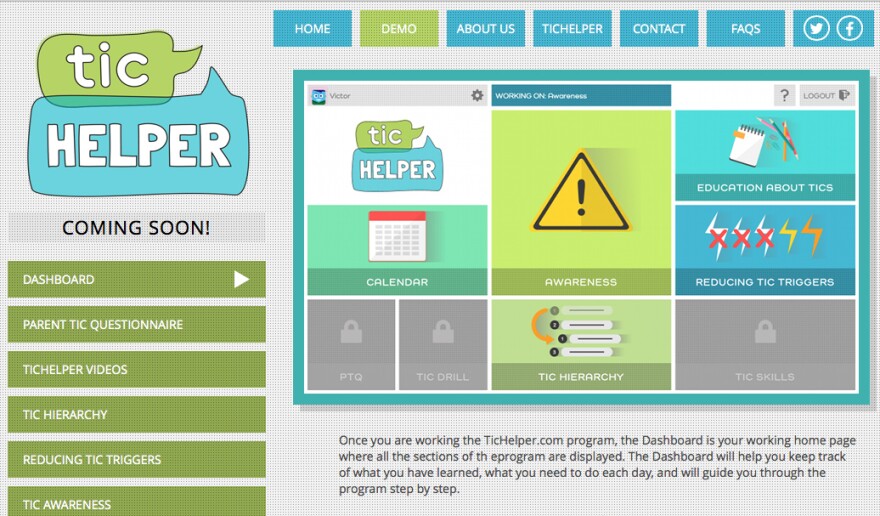If you've ever had hiccups in a quiet room, you know how embarrassing and completely uncontrollable they can feel. What if, instead of the hiccups, your body jerked involuntarily or you blurted out words without meaning to? That's a rough idea of what living with Tourette syndrome can be like.
Designers of a new computer program called hope that they will be able to help children recognize and control these impulses themselves.
People with Tourette's perform repetitive movements or vocalizations called tics. A simple tic might be something like head jerking, eye blinking, or throat clearing, and a complex tic might involve patterns of movement or saying multiple words or phrases.
We don't know exactly what causes Tourette's, says Douglas Woods, a psychologist at Texas A&M University. Woods, who is also co-chair of the Medical Advisory Board, is one of the minds behind TicHelper.
Tourette's affects more boys than girls, and symptoms usually start between ages 3-7.

"Sometimes kids will grow out of [Tourette's]," Woods says. But if the wait-and-see approach isn't working, and the tics are interfering with daily life, there are a few treatment options.
One option is medication. Woods says there are a few different antipsychotic drugs that are used to manage Tourette syndrome, but they have side effects and don't always work. An alternative to pharmaceutical treatment is behavioral therapy.
A form of behavioral therapy called comprehensive behavioral intervention for tics, or CBIT for short, is commonly used. CBIT training teaches people with Tourette's to recognize the onset of a tic and to perform a different behavior when they feel one coming on.
"The idea is that when someone has a tic, they tend to have an urge," says clinical psychologist Eric Storch, a professor at the University of South Florida and Clinical Director of Pediatrics at Rogers Memorial Hospital in Tampa. "It's like when you're about to yawn. You know just before it happens that a yawn's coming. [CBIT] teaches a person to be aware."
And it gives them the tools to manage tics. Storch describes a patient whose tic was rubbing two fingers together, to the point of rubbing off skin. With CBIT, the boy was able to recognize the onset of a tic and instead unobtrusively press down on his kneecap until the urge went away.
A typical CBIT training program involves eight sessions with a therapist, spread over 10 weeks. Results, Woods says, can be maintained up to six months.
Both psychologists say that CBIT is at least as effective as medical treatments. The problem is that it requires specially trained therapists — and there aren't that many of them. Which is where TicHelper comes in.
"It's essentially a self-help, self-guided program that leads the patient through a CBIT treatment," Woods says. He and his colleagues received funding from the National Institute of Mental Health to develop TicHelper, which is now being tested. So far, the results look promising. "The kids that go through it, enjoy it," Woods says. They're able to do the skills,"
The program has four main sections: tic education, reducing tic triggers, tic awareness and tic blocking. Videos featuring a friendly actress guide patients thorough each section. The program personalizes treatment based on feedback from the patient. Woods says the testing will help the designers modify and improve it based on user feedback. Though TicHelper isn't available yet, interested patients or doctors can sign up to receive updates on its progress.
The website currently lists the cost of an 8-week program through TicHelper at $150, but Woods says that the price isn't set.
Storch, who is unaffiliated with TicHelper, is enthusiastic about the idea of at-home treatment for tics. "I really think it's an exciting development that has a lot of practicality," he says. "We know what behavioral treatments work well for tics, but the dissemination is really terrible."
Storch says the biggest advantage of TicHelper will be its accessibility. CBIT, he says, works well and is incredibly safe compared with pharmaceuticals. TicHelper would maximize the benefits of CBIT by making it more inexpensive and easier to get to than therapy.
Which is not to say that Storch or Woods would recommend TicHelper as the only form of tic management. Both psychologists suggest that this program might work best as part of a management plan. One option, Woods says, might be to start treatment with TicHelper at first diagnosis and proceed to more intensive care if in-home treatment isn't working.
Storch thinks that ideally the patient would work with the program, but touch base periodically with an experienced therapist or health care provider to check progress. But, he says, "we don't have enough providers." And some treatment, he says, is better than no treatment at all.
Copyright 2020 NPR. To see more, visit https://www.npr.org. 9(MDA4MDYxNjY4MDEzMTQ2OTkxMzkyOWU2NQ004))


